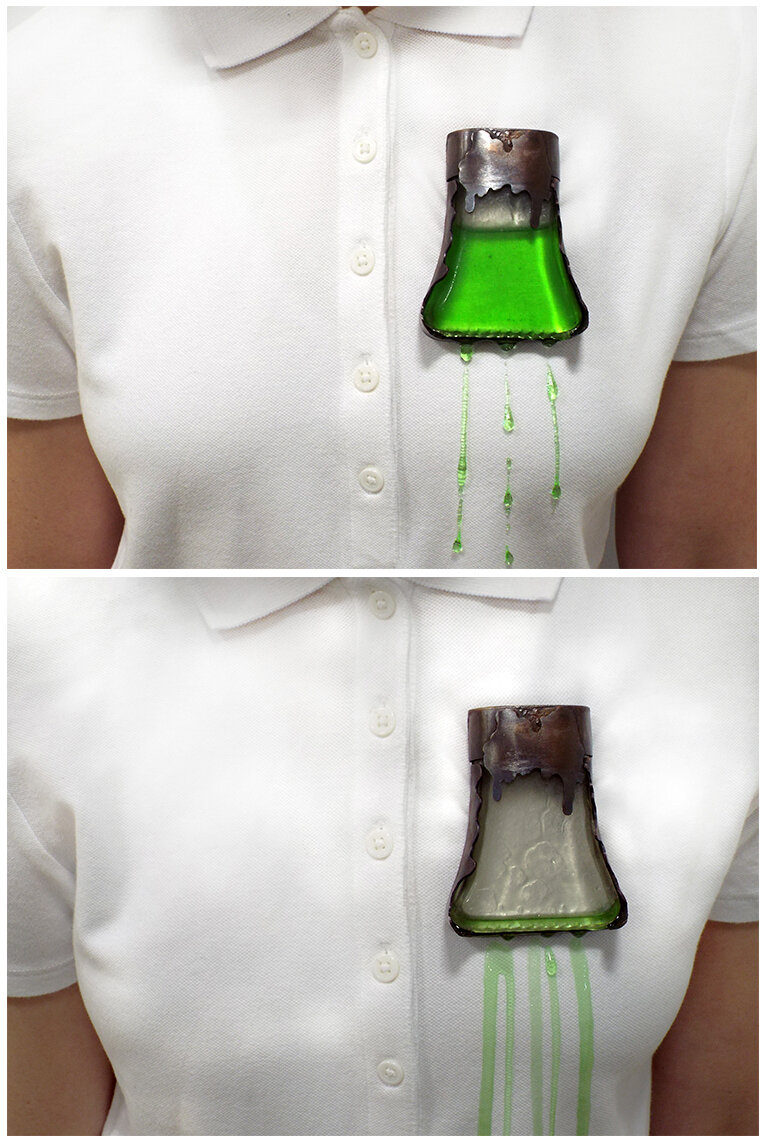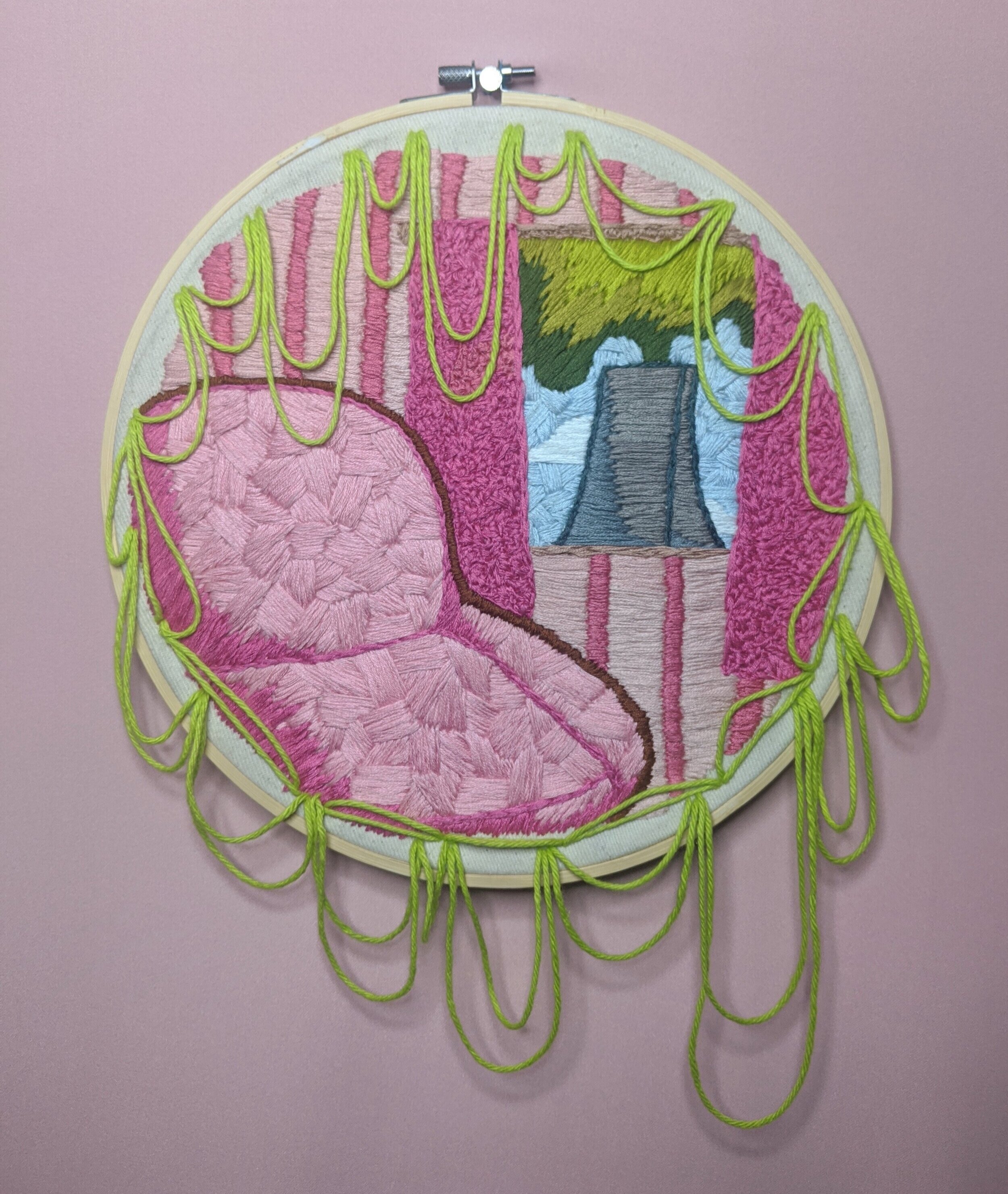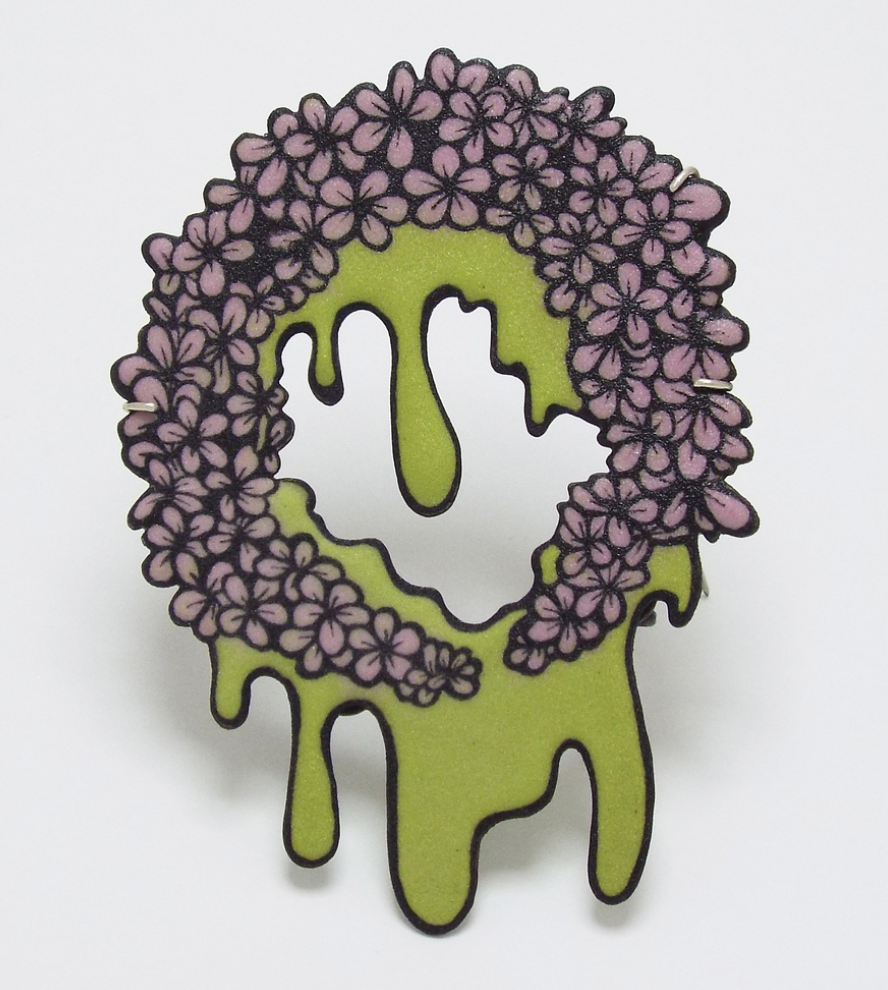E M I L Y P E L L I N I
Emily Pellini’s work is a combination of narrative and symbolism with personal iconography used throughout. She has received her BFA in Fine Art Metals and Jewelry from Millersville University, studying under Becky McDonah, and was a Millersville Emerging Artist in Residence. She recently completed her MFA in Metals at Ball State University, studying under Jessica Calderwood.
Pellini was awarded Juror's Awards in the 38th and 41st Annual Contemporary Craft in Mesa, AZ. Her belt buckles, Easy, Breezy, Beautiful: Nervous Girl, All Men Are Cremated Equal, and Swarming have received Honorable Mention in the 2020, 2019, and 2016 World Champion Belt Buckle Competitions. Publications include New Brooches, which features three brooches from the Swarming: Brooch Series, SNAG: JAMS, and The Art of Fine Enameling by Karen L. Cohen.
Interview by Ariella Har-Even
Hi Emily! How are you doing? I’m so excited to talk a little about your practice and get to pick your brain about everything from enamel to uranium!
Thank you and hello!
To start, tell us a little about yourself, your work, and how you came to be interested in metalsmithing and craft.
I am from Kennett Square, Pennsylvania, which is about an hour outside of Philadelphia. Kennett Square is actually the Mushroom CAPital of the world! It smells terrible, but is also home to a large botanical garden, Longwood Gardens. So it’s quite beautiful too.
My work is extremely narrative and full of my own symbols. My patterns and icons become this kind of short-hand language to decode, and I am interested in the control of how much an artist can reveal to a viewer versus how much needs this uncovering.
I have been a lifelong artist, although I never thought I would actually pursue the art field. In high school I actually went to a vocational school for Animal Science and Technology and later for teaching where I thought I might teach English. I basically tried a lot of things until I ended up at Millersville University for Art Education. I took a 3D design class with wonderful professor, Becky McDonah, who also taught Metals, so I took that too. I think I changed my major within the first month of that Metals semester. Love at first piercing.
One of the biggest catalysts in creating Commence Jewelry was Covid-19 and its effects on not only thesis shows, but also inevitably what the Jewelry+Metals landscape looks like as artists emerge into it post-graduation. Can you tell us about the ways in which Covid changed or shaped your experience as a student and as a maker?
As a student, Covid 19 changed a great deal of my plans. I like to plan in advance, and when a pandemic hits and the world suddenly says plans cannot be, well, I get nervous. I’m nervous quite a bit already, so really this was throwing me in to overdrive. I ended up setting my thesis show in the gallery a week early, which meant even as I was taking portfolio photos there were details missing. Stores I needed to purchase materials from suddenly were closed. I was building a false room with electronics, but all of a sudden there was a lack of this material or that. A lot of delirious decision making, and fellow grad begging happened, but it went up! Not entirely as I wanted, but I passed my final review, so I am content.
As a maker I immediately and without much warning lost my studio. This was year eight of my education, and, I think, the sixth year of my Metals career. We were kicked from our studios for safety concerns with no foreseeable way of returning. I had to clean out my studio in multiple, recorded, 20-minute shifts. It was heartbreaking. Then I decided it was time to move back to Pennsylvania to try and set up shop there. After a while in quarantine I reached out to a friend with a studio, Caryn Hetherston, a lifelong instructor and art jeweler. I now have a bench, a space, and a wonderful studio mate. But I am adjusting to working smaller, with different equipment and a different mindset. Eventually you adapt.
Your work uses nuclear power, both through imagery and the use of uranium oxides, to discuss themes of family, loss, and mourning. I’m interested in the tensions you create within this body of work. For instance, the tension between nucleus - a vessel containing DNA, building material responsible for creation and continuity, and nuclear power being so connotative of destruction, its imagery conjuring definite unease. Were tensions such as this something you planned for and then worked into your imagery, text, and form? Or did they bob up to the surface more organically as you developed the work?
I wish I could say it was that amazingly deep! I started drawing nuclear cooling towers because my grandfather, who had recently died, used to work in them. He worked mainly in Three Mile Island, Peach Bottom, and most of the lower east PA sites. I did not know that much about them, so when I was picking my thesis committee I began talking with an anthropologist at Ball State who had done research at the Hanford Site in Washington. Without going into a crazy amount of darker US wartime history, it is a site where the dumping of radioactive materials was handled very poorly and has continued to affect the surrounding areas long after. My earlier pieces were about the tension of this poisoning of our environment mixed with this abstracted view of grief and mourning for my grandfather. While I was researching this and early drafting thesis work, my grandmother died. I actually lost a number of family members while in grad school, some really shaking me to my core. My grandmother had raised me through much of my childhood, and not being there for her in the end really warped my views on essentially everything around me. So this cooling tower, the smoke, the icon of it all became my symbol for this great loss, and later for communication with those gone. The towers are scary because we are exposed to all the ways in which they can harm us. But to my grandfather, it was a job, and a means to live. Uranium glass became this easy extension of it all – a natural progression. It is a little frightening, a little radioactive, and it glows! So that is really the whole thing – perceptions of fear and loss.
I’m so sorry. I actually lost both of my grandparents this year as well. It brings to mind a sentence in your statement in which you write, “this project aims to connect with viewers who have also dealt with loss and the changes that come with it”. Do you think that has taken on new meaning given the immense amount of loss people have experienced this year on personal, national, and global scales?
I think about this a lot, actually. There are probably thousands of people sitting at a dinner tables with empty seats. There is so much more that comes with the passing of a loved one. What they leave behind, not just physical, but in memory as well. Not only did thousands of people go into lockdown, but they had to survive it without these people lost to Covid. I very much understand that the loss of one core family member can throw your life into chaos, breakdown a family, devastate a household. I said goodbye to my grandmother on a video call, just like plenty of others have had to do. That sticks with you. That truly hurts. Loss can show us how we break, but also how strong we can be without the people we may have relied upon, emotionally, physically, etc. It changes you.
You make a wide range of objects including wearables, utensils, and wall pieces. How important do you feel the body is to your work? Do you feel the form is somewhat dictated by material, or vice versa?
The body became less important when the work became usable items. The work was saying things about bodies that were no longer present, so I felt that it was strange to make wearables for them. I think it would have been an extra layer of sad on a downer of a show, to see a brooch for a deceased person they would never wear.
As a Metalsmith, however, I love to use the body! Much of my past work had very precisely selected wearers. If the piece were supposed to be worn by me, I had a model stand in with a collared shirt so I could still take the photos.
Overall, I try to look at what I am trying to say. It was really hard to move away from wearables because I love to make them. But for my MFA show what I loved to make was not necessarily what the work needed. What I needed was to branch out.
Do you have a favorite material to work with, or is that like asking who your favorite child is? In what ways do you think your material sensibilities have changed from undergrad through graduate school?
Enamel on copper is my sweet spot. There is nothing quite as satisfying as watching a hot piece cool perfectly fresh out of the kiln. Copper is also relatively cheap, and I only really worked with opaque enamels, so you would never know what the metal is really, unless you know how enameling works. I have been constructing with copper since undergrad, and really if it is cost effective and gives me the results I want I saw no problem continuing with it into grad school. However, my enamel game has absolutely stepped up. We have special oils, pigments, powders, pens, and personalized hand tools. I stayed relatively within my means, and I tried to justify my purchases with the sale of other pieces. Any jewelry findings are skin safe, however!
Tell us a little about your choice to attend Ball State University, and how you feel it shaped and affected you as a maker.
I chose to attend Ball State University because it was a new program with an excellent head of Metals (Jessica Calderwood) and a graduate assistantship program that meant I would receive a tuition reimbursement and get a chance to teach. I would not have been able to attend grad school if it were not at least partially funded. As a maker it was absolutely worth it. I had amazing students that really showed me how education can go both ways, and I learned just as much from my students as they (hopefully) did from me. Education and the furthering of the field has become my main focus going forward. My goals are pretty much where can I teach, what can I teach, and how can I teach it here?
What role does writing play for you, within the work as well as your process?
As you may infer from my longwinded answers, I love to write! Creative writing is extremely important to me. I think everyone could benefit from it every once in a while. All the pieces in (You Should) Take It With You have a companion poem that acts as a little key to figuring out its story. The show featured a handmade, illustrated book that featured these poems and really helped me organize my thoughts about them. I also read a lot, and much of what I read ended up as research. Reading here refers to hours of audiobooks while enameling.
Finally, any words of wisdom for students currently working on their thesis?
Make plans! Even if a pandemic says you can’t. NOTE: Not “go out and be unsafe plans”, but, career-wise. List your long-term goals because you should probably know your short-term ones. It is future goals that motivate you.
Ask questions, a lot of them! Find people that you can share your thoughts with, even if they are not artists. I do not think my partner knows what my work is about, but I have come up with some great ideas just talking about it.
If your school has a lot of great, expensive equipment, use it all before you leave. Try new techniques. Write about what you are making often, so you can talk about it with your professors and peers. Go to sleep when you are too exhausted to work. Do your homework so you can graduate.
I wish I could personally tell all thesis students that it will be okay and if you work hard you will achieve your goals, which you obviously established earlier.








